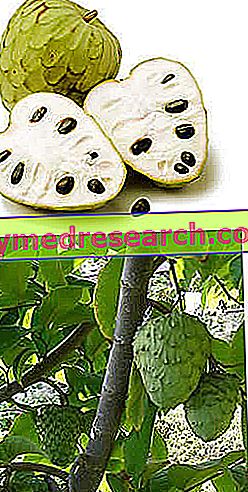What is Cherimoya
The cherimoya, also written chirimoya, is the fruit of a plant belonging to the genus Annona, Species cherimola ; the binomial nomenclature of this vegetable is Annona cherimola .

Cherimoya is hypothetically native to the American continent, but it is still not clear whether it comes from the mountainous colony of the Andes or from Central America (where there are numerous similar species).
Today, Cherimoya plants are grown throughout southern Asia, Central America, South America, Southern California, Portugal, Southern Andalusia and Southern Italy.
Description
That of cherimoya is an evergreen shrub plant, of modest size (maximum 7m in height). The leaves are alternate, simple, lanceolate, about 7-15cm long and 6-10cm wide. Cherimoya flowers are grouped and small (2-3cm), with six yellow-brown petals, sometimes speckled with violet at the base.
The fruit of the cherimoya is oval, 10-20cm long and about 7-10cm wide; the dimensions are roughly those of a grapefruit. The skin is smooth and only slightly tuberculated. The pulp of the cherimoya is white, of a creamy consistency and has in dispersion a large number of easily removable brown seeds.
The organoleptic and taste characteristics are excellent, also thanks to the typically sweet taste. The overall taste resembles a mix of banana, pineapple, papaya, peach and strawberry.
Composition for: 100g of Cherimoya | ||||||||||||||||||||||||||||||||||||||||||||||||||||||||||||||||||||||||||||||||||||||||||||||||||||||||||||||||||||||||||||||||||||||||||||
 | ||||||||||||||||||||||||||||||||||||||||||||||||||||||||||||||||||||||||||||||||||||||||||||||||||||||||||||||||||||||||||||||||||||||||||||
Nutritional values (per 100 g of edible portion)
| ||||||||||||||||||||||||||||||||||||||||||||||||||||||||||||||||||||||||||||||||||||||||||||||||||||||||||||||||||||||||||||||||||||||||||||
When fully ripe, the peel is green and yields slightly to digital pressure in a manner similar to avocado. Also for this reason, cherimoya can be eaten cut in two and then emptied by means of a teaspoon (similar to an ice cream).
Nutritional Features
Cherimoya is a product of plant origin that belongs to the VII group of foods; like the other foods of this group, it is distinguished by the good content of vitamin C (ascorbic acid).
Cherimoya is a watery fruit and has the same nutritional function as apples, pears, peaches, apricots, pineapples, etc., that is, it provides sugars, water and water-soluble vitamins. On the contrary, it differs from coconut, from avocado and from dried fruit (walnuts, hazelnuts, almonds, pine nuts, pistachios, cashews, pecans, etc.), which provide greater quantities of lipids and fat-soluble vitamins.
The proportion of cherimoya fibers is good, as is the intake of potassium. As regards vitamins, we have already mentioned, ascorbic acid (vitamin C) stands out above all. However, this is a contribution that is little more than modest, much lower than that of citrus fruits or strawberries (which contain 4/5 times more).
The overall nutritional framework of cherimoya does not differ much from the average of sweet fruits and energy intake is quite important. This food must be consumed in the same portions of the grapes (autumn fruit, 150-300g / day), and not in those of the melon, watermelon or peaches (summer fruit, 250-500g / day).
In addition to its nutritional properties, cherimoya is distinguished by an important phytotherapeutic characteristic, namely the presence of annonacin ( acetogenin ), a polyphenol. This molecule is known for its antioxidant and antitumor capacity ; however, its potentially neurotoxic effect (at high concentrations) is suspected of being responsible for atypical parkinsonian forms observed in Guadeloupe (probably, following chronic and significant exposure).
Furthermore, the crushed seeds (as well as the bark) of cherimoya have strong VENETIC capacities and, in quantities of 10 or 20, are deadly.



